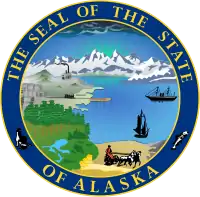Fairbanks, Alaska
Fairbanks (Lower Tanana: Tanan) is a home rule city and the borough seat of the Fairbanks North Star Borough in the U.S. state of Alaska.[5]
Fairbanks, Alaska
| |
|---|---|
| City of Fairbanks | |
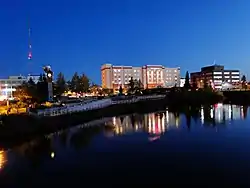 Downtown Fairbanks in 2009 | |
 Seal | |
| Motto(s): The Golden Heart of Alaska | |
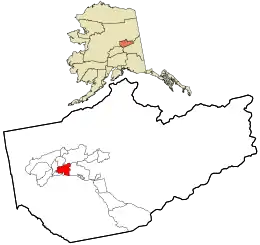 Location within Fairbanks North Star Borough and the U.S. state of Alaska | |
| Coordinates: 64°50′37″N 147°43′23″W | |
| Country | United States |
| State | Alaska |
| Borough | Fairbanks North Star |
| Incorporated | November 10, 1903[1] |
| Government | |
| • Type | Home rule city |
| • Mayor | Jim Matherly |
| • State senators | Click Bishop (R)[2] Scott Kawasaki (D) |
| • State reps. | Bart LeBon (R) Steve Thompson (R) Adam Wool (D)[2] |
| Area | |
| • City | 32.62 sq mi (84.49 km2) |
| • Land | 31.75 sq mi (82.22 km2) |
| • Water | 0.88 sq mi (2.28 km2) |
| Elevation | 446 ft (136 m) |
| Population (2010) | |
| • City | 31,535 |
| • Estimate (2019)[4] | 30,917 |
| • Density | 973.92/sq mi (376.03/km2) |
| • Urban | 51,926 |
| • Metro | 100,605 |
| Demonym(s) | Fairbanksan |
| Time zone | UTC−9 (AKST) |
| • Summer (DST) | UTC−8 (AKDT) |
| ZIP Codes | 99701, 99702, 99703, 99705, 99706, 99707, 99708, 99709, 99710, 99711, 99712, 99714, 99716, 99725 (Ester), 99767, 99775-(UAF), 99790 |
| Area code | 907 |
| FIPS code | 02-24230 |
| GNIS ID | 1401958 |
| Website | www |
Fairbanks is the largest city in the Interior region of Alaska. 2019 estimates put the population of the city proper at 30,917,[6] and the population of the Fairbanks North Star Borough at 96,849,[7] making it the second most populous metropolitan area in Alaska (after Anchorage). The Metropolitan Statistical Area encompasses all of the Fairbanks North Star Borough and is the northernmost Metropolitan Statistical Area in the United States, located 196 miles (315 kilometers) by road (140 mi or 230 km by air) south of the Arctic Circle. Fairbanks is home to the University of Alaska Fairbanks, the founding campus of the University of Alaska system.
History
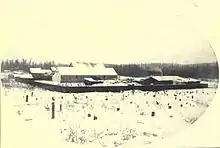
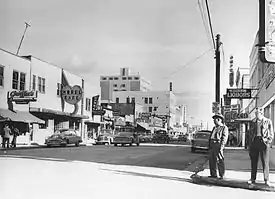

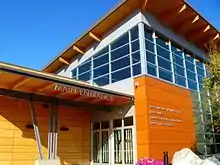
Native American presence
Athabascan peoples have used the area for thousands of years, although there is no known permanent Alaska Native settlement at the site of Fairbanks. An archaeological site excavated on the grounds of the University of Alaska Fairbanks uncovered a Native camp about 3,500 years old, with older remains found at deeper levels.[8] From evidence gathered at the site, archaeologists surmise that Native activities in the area were limited to seasonal hunting and fishing as frigid temperatures precluded berry gathering.[9] In addition, archaeological sites on the grounds of nearby Fort Wainwright date back well over 10,000 years.[10] Arrowheads excavated from the University of Alaska Fairbanks site matched similar items found in Asia, providing some of the first evidence that humans arrived in North America via the Bering Strait land bridge in deep antiquity.[8]
European settlers
Captain E. T. Barnette founded Fairbanks in August 1901 while headed to Tanacross (or Tanana Crossing, where the Valdez–Eagle trail crossed the Tanana River), where he intended to set up a trading post. The steamboat on which Barnette was a passenger, the Lavelle Young, ran aground while attempting to negotiate shallow water. Barnette, along with his party and supplies, were deposited along the banks of the Chena River 7 miles (11 km) upstream from its confluence with the Tanana River. The sight of smoke from the steamer's engines caught the attention of gold prospectors working in the hills to the north, most notably an Italian immigrant named Felice Pedroni (better known as Felix Pedro) and his partner Tom Gilmore. The two met Barnette where he disembarked and convinced him of the potential of the area. Barnette set up his trading post at the site, still intending to eventually make it to Tanacross.[11] Teams of gold prospectors soon congregated in and around the newly founded Fairbanks; they built drift mines, dredges, and lode mines in addition to panning and sluicing.[12]
After some urging by James Wickersham, who later moved the seat of the Third Division court from Eagle to Fairbanks, the settlement was named after Charles W. Fairbanks, a Republican senator from Indiana and later the twenty-sixth Vice President of the United States, serving under Theodore Roosevelt during his second term.[13]
In these early years of settlement, the Tanana Valley was an important agricultural center for Alaska until the establishment of the Matanuska Valley Colonization Project and the town of Palmer in 1935. Agricultural activity still occurs today in the Tanana Valley, but mostly to the southeast of Fairbanks in the communities of Salcha and Delta Junction. During the early days of Fairbanks, its vicinity was a major producer of agricultural goods. What is now the northern reaches of South Fairbanks was originally the farm of Paul J. Rickert, who came from nearby Chena in 1904 and operated a large farm until his death in 1938.[14] Farmers Loop Road and Badger Road, loop roads north and east (respectively) of Fairbanks, were also home to major farming activity. Badger Road is named for Harry Markley Badger, an early resident of Fairbanks who later established a farm along the road and became known as "the Strawberry King".[15] Ballaine and McGrath Roads, side roads of Farmers Loop Road, were also named for prominent local farmers, whose farms were in the immediate vicinity of their respective namesake roads. Despite early efforts by the Alaska Loyal League, the Tanana Valley Agriculture Association and William Fentress Thompson, the editor-publisher of the Fairbanks Daily News-Miner, to encourage food production, agriculture in the area was never able to fully support the population, although it came close in the 1920s.[16]
The construction of Ladd Army Airfield starting in 1939, part of a larger effort by the federal government during the New Deal and World War II to install major infrastructure in the territory for the first time, fostered an economic and population boom in Fairbanks which extended beyond the end of the war. In the 1940s the Canol pipeline extended north from Whitehorse for a few years. The Haines - Fairbanks 626 mile long 8" petroleum products pipeline was constructed during the period 1953-55.[17] The presence of the U.S. military has remained strong in Fairbanks. Ladd became Fort Wainwright in 1960; the post was annexed into Fairbanks city limits during the 1980s.
Fairbanks suffered from several floods in its first seven decades, whether from ice jams during spring breakup or heavy rainfall. The first bridge crossing the Chena River, a wooden structure built in 1904 to extend Turner Street northward to connect with the wagon roads leading to the gold mining camps, often washed out before a permanent bridge was constructed at Cushman Street in 1917 by the Alaska Road Commission.[18] On August 14, 1967, after record rainfall upstream, the Chena began to surge over its banks, flooding almost the entire town of Fairbanks overnight. This disaster led to the creation of the Chena River Lakes Flood Control Project, which built and operates the 50-foot-high (15 m) Moose Creek Dam in the Chena River and accompanying 8-mile-long (13 km) spillway. The project was designed to prevent a repetition of the 1967 flood by being able to divert water in the Chena upstream from Fairbanks into the Tanana River, thus bypassing the city.[19]
Geography and climate
Topography

Fairbanks is in the central Tanana Valley, straddling the Chena River near its confluence with the Tanana River. Immediately north of the city is a chain of hills that rises gradually until it reaches the White Mountains and the Yukon River. The city's southern border is the Tanana River. South of the river is the Tanana Flats, an area of marsh and bog that stretches for more than 100 miles (160 km) until it rises into the Alaska Range, which is visible from Fairbanks on clear days.[20] To the east and west are low valleys separated by ridges of hills up to 3,000 feet (910 m) above sea level.[21]
The Tanana Valley is crossed by many low streams and rivers that flow into the Tanana River. In Fairbanks, the Chena River flows southwest until it empties into the Tanana.[21] Noyes Slough, which heads and foots off the Chena River, creates Garden Island, a district connected to the rest of Fairbanks by bridges and culverted roads.[22]
According to the United States Census Bureau, the city has an area of 32.7 square miles (85 km2); 31.9 square miles (83 km2) of it is land and 0.8 square miles (2.1 km2) of it (2.48%) is water.
Location
The city is extremely far north, being close to 16 degrees north of the Pacific border between the U.S. and Canada. It is on roughly the same parallel as the northern Swedish city of Skellefteå and Finnish city of Oulu. On account of its warm summers, however, Fairbanks is south of the arctic tree line.
Climate
Fairbanks’ climate is classified as subarctic (Köppen Dfc close to Dwc),[23] with long cold winters and short warm summers. October through January are the snowiest months, and snow is limited from February to May. On average, the season's first snow falls on September 21, the first inch of snow accumulates by October 8 and the last inch of snow falls on April 27. The last flurries happen in April on average, but it occasionally does flurry in May. The snowpack is established by October 18, on average, and remains until April 23.[24] Snow occasionally arrives early and in large amounts. On September 13, 1992, 8 inches (20 cm) of snow fell in the city, bending trees still laden with fall leaves. That September was also one of the snowiest on record, as 24 inches (61 cm) fell, compared to a median[25] of only 0.3 inches or 0.0076 metres during the month.[26] October and November are the snowiest months, whilst in contrast, March and April are not very snowy, as these are typically very dry months in central Alaska. The snowiest season has been from July 1990 to June 1991 with 147.3 inches (3.74 m), whilst the least snowy was from July 1918 to June 1919 with only 12.0 inches (0.30 m).[27]
The average first and last dates with a freezing temperature are September 9 and May 15, respectively, allowing a growing season of 116 days, although freezes have occurred in June, July, and August and the last light frost is often in early June and the first light fall frost is often in late August or early September.[27]
Fairbanks is the coldest large city in the U.S.;[28] normal monthly mean temperatures range from −7.9 °F (−22.2 °C) in January to 62.5 °F (16.9 °C) in July.[27] On average, temperatures reach −40 °F (−40 °C) and 80 °F (27 °C) on 7.3 and 13 days annually, respectively, and the last year that failed to reach the former mark was 2016.[27] Between 1995 and 2008, inclusive, Fairbanks failed to record a temperature of 90 °F or 32 °C.[29] The highest recorded temperature in Fairbanks was 99 °F (37 °C) on July 28, 1919, compared to the Alaska-wide record high temperature of 100 °F (38 °C), recorded in Fort Yukon. The lowest was −66 °F (−54 °C) on January 14, 1934.[27] The warmest calendar year in Fairbanks was 1926, when the average annual temperature was 32.4 °F (0.2 °C), while the coldest was 1956 with an annual mean temperature of 21.3 °F (−5.9 °C).[27] The warmest month has been July 1975 with a monthly mean of 68.4 °F (20.2 °C) and the coldest January 1906 which averaged −36.4 °F (−38.0 °C).[27] Low temperatures below 0 °F or −18 °C have been recorded in every month outside June through September. The record cold daily maximum is −58 °F (−50 °C) on January 18, 1906, and the record warm daily minimum is 76 °F (24 °C) on June 26, 1915; the only other occurrence of a 70 °F (21 °C) daily minimum was June 25, 2013 in the midst of a particularly warm summer.[27]
These widely varying temperature extremes are due to three main factors: temperature inversions, daylight, and wind direction.[30] In winter, Fairbanks' low-lying location at the bottom of the Tanana Valley causes cold air to accumulate in and around the city. Warmer air rises to the tops of the hills north of Fairbanks, while the city itself experiences one of the biggest temperature inversions on Earth.[31] Heating through sunlight is limited because of Fairbanks's high-latitude location. At the winter solstice, the center of the sun's disk is less than two degrees over the horizon (1.7 degrees) at the local noon (not the time zone noon). Fairbanks experiences 3 hours and 41 minutes of sunlight on December 21 and 22. At the summer solstice, about 182 days later, on June 20 and 21, Fairbanks receives 21 hours and 49 minutes of sunlight.[32] After sunset, twilight is bright enough to allow daytime activities without any electric lights, since the center of the sun's disk is just 1.7 degrees below horizon.[33] During winter, the direction of the wind also causes large temperature swings in Fairbanks. When the wind blows from any direction but the south, average weather ensues. Wind from the south can carry warm, moist air from the Gulf of Alaska, greatly warming temperatures. When coupled with a chinook wind, temperatures well above freezing often result:[34][35] for example, in the record warm January 1981, Fairbanks’ average maximum was 28.7 °F (−1.8 °C) and 15 days had a maximum above freezing, whilst during a spell of sustained chinook winds from December 4 to 8, 1934 the temperature topped 50 °F or 10 °C for five consecutive days.[27]
In addition to the chinook wind, Fairbanks experiences a handful of other unusual meteorological conditions. In summer, dense wildfire smoke accumulates in the Tanana Valley, affecting the weather and causing health concerns.[36][37] When temperature inversions arise in winter, heavy ice fog often results. Ice fog occurs when air is too cold to absorb additional moisture, such as that released by automobile engines or human breath. Instead of dissipating, the water freezes into microscopic crystals that are suspended in the air, forming fog.[38] Another one of Fairbanks' unusual occurrences is the prevalence of the aurora borealis, commonly called the northern lights, which are visible on average more than 200 days per year in the vicinity of Fairbanks.[39] The northern lights are not visible in the summer months due to the 24 hour daylight of the midnight sun. Fairbanks also has extremely low seasonal lag; the year's warmest month is July, which averages only 2.1 °F (1.2 °C) warmer than June. Average daily temperatures begin to fall by late July and more markedly in August, which on average is 4.3 °F (2.4 °C) cooler than June.[27]
From 1949 to 2018, Fairbanks's mean annual temperature has risen by 3.9 °F (2.2 °C), a change comparable to the Alaska-wide average; winter was the season with the highest increase, at 8.1 °F (4.5 °C),[40] while autumn had the smallest, at only 1.5 °F (0.83 °C).[40] However, the mean annual temperature increase from 1976 to 2018 in Fairbanks stood at a more moderate 0.7 °F (0.39 °C); this stepwise temperature change, also observed elsewhere in Alaska, is explained by the Pacific Decadal Oscillation shifting from a negative phase to a positive phase from 1976 onward.[40]
| Climate data for Fairbanks International Airport, Alaska (1981–2010 normals,[41] extremes 1904–present) | |||||||||||||
|---|---|---|---|---|---|---|---|---|---|---|---|---|---|
| Month | Jan | Feb | Mar | Apr | May | Jun | Jul | Aug | Sep | Oct | Nov | Dec | Year |
| Record high °F (°C) | 52 (11) |
50 (10) |
56 (13) |
76 (24) |
90 (32) |
96 (36) |
99 (37) |
93 (34) |
84 (29) |
72 (22) |
54 (12) |
58 (14) |
99 (37) |
| Mean maximum °F (°C) | 29.7 (−1.3) |
35.2 (1.8) |
44.7 (7.1) |
61.8 (16.6) |
75.6 (24.2) |
84.9 (29.4) |
85.1 (29.5) |
80.2 (26.8) |
68.2 (20.1) |
52.6 (11.4) |
32.4 (0.2) |
32.2 (0.1) |
87.3 (30.7) |
| Average high °F (°C) | 1.1 (−17.2) |
10.0 (−12.2) |
25.4 (−3.7) |
44.5 (6.9) |
61.0 (16.1) |
71.6 (22.0) |
72.7 (22.6) |
65.9 (18.8) |
54.6 (12.6) |
31.9 (−0.1) |
10.9 (−11.7) |
4.8 (−15.1) |
38.0 (3.3) |
| Average low °F (°C) | −16.9 (−27.2) |
−12.7 (−24.8) |
−2.5 (−19.2) |
20.6 (−6.3) |
37.8 (3.2) |
49.3 (9.6) |
52.3 (11.3) |
46.4 (8.0) |
35.1 (1.7) |
16.5 (−8.6) |
−5.7 (−20.9) |
−12.9 (−24.9) |
17.4 (−8.1) |
| Mean minimum °F (°C) | −41.3 (−40.7) |
−36.2 (−37.9) |
−24.4 (−31.3) |
−2.8 (−19.3) |
26.8 (−2.9) |
39.6 (4.2) |
44.4 (6.9) |
35.1 (1.7) |
22.5 (−5.3) |
−5.6 (−20.9) |
−26.7 (−32.6) |
−37.2 (−38.4) |
−45.9 (−43.3) |
| Record low °F (°C) | −66 (−54) |
−58 (−50) |
−56 (−49) |
−32 (−36) |
−1 (−18) |
28 (−2) |
30 (−1) |
21 (−6) |
3 (−16) |
−28 (−33) |
−54 (−48) |
−62 (−52) |
−66 (−54) |
| Average precipitation inches (mm) | 0.58 (15) |
0.42 (11) |
0.25 (6.4) |
0.31 (7.9) |
0.60 (15) |
1.37 (35) |
2.16 (55) |
1.88 (48) |
1.10 (28) |
0.83 (21) |
0.67 (17) |
0.64 (16) |
10.81 (275) |
| Average snowfall inches (cm) | 10.3 (26) |
8.1 (21) |
4.9 (12) |
2.9 (7.4) |
0.9 (2.3) |
trace | 0 (0) |
trace | 1.8 (4.6) |
10.8 (27) |
13.2 (34) |
12.1 (31) |
65.0 (165) |
| Average precipitation days (≥ 0.01 in) | 8.5 | 6.6 | 4.8 | 3.6 | 7.1 | 10.9 | 12.9 | 13.3 | 10.4 | 11.2 | 10.3 | 9.0 | 108.6 |
| Average snowy days (≥ 0.1 in) | 10.1 | 7.9 | 5.9 | 2.8 | 0.8 | 0 | 0 | 0 | 1.4 | 10.2 | 11.9 | 10.8 | 61.8 |
| Average relative humidity (%) | 69.3 | 65.5 | 60.4 | 56.2 | 50.2 | 56.6 | 64.2 | 70.8 | 68.9 | 74.1 | 72.8 | 71.3 | 65.0 |
| Average dew point °F (°C) | −17.0 (−27.2) |
−11.9 (−24.4) |
−0.2 (−17.9) |
16.2 (−8.8) |
29.7 (−1.3) |
42.6 (5.9) |
48.7 (9.3) |
46.0 (7.8) |
34.5 (1.4) |
17.4 (−8.1) |
−3.8 (−19.9) |
−13.2 (−25.1) |
15.8 (−9.0) |
| Mean monthly sunshine hours | 54 | 120 | 224 | 302 | 319 | 334 | 274 | 164 | 122 | 85 | 71 | 36 | 2,105 |
| Source 1: [42][43] NOAA (relative humidity 1961–1990)[27][25][44] | |||||||||||||
| Source 2: Danish Meteorological Institute (sun, 1931–1960)[45] | |||||||||||||
People and culture
Demographics
| Historical population | |||
|---|---|---|---|
| Census | Pop. | %± | |
| 1910 | 3,541 | — | |
| 1920 | 1,155 | −67.4% | |
| 1930 | 2,101 | 81.9% | |
| 1940 | 3,455 | 64.4% | |
| 1950 | 5,771 | 67.0% | |
| 1960 | 13,311 | 130.7% | |
| 1970 | 14,771 | 11.0% | |
| 1980 | 22,645 | 53.3% | |
| 1990 | 30,843 | 36.2% | |
| 2000 | 30,224 | −2.0% | |
| 2010 | 31,535 | 4.3% | |
| 2019 (est.) | 30,917 | [4] | −2.0% |
| U.S. Decennial Census[46] | |||
Fairbanks first appeared on the 1910 U.S. Census as an incorporated city. It incorporated in 1903.
The U.S. Census Bureau estimates that the population of the city in 2011 was 32,036 people, 11,075 households, and 7,187 families residing in the city. The population density was 995 people per square mile (366.3/km2). There were 12,357 housing units at an average density of 387.9 per square mile (149.8/km2). The racial makeup of the city was 65.0% White, 10.0% Black or African American, 10.1% Native American or Alaska Native, 5.1% Asian (1.92% Filipino, 1.15% Korean, 0.62% Laotian, 0.37% Chinese, 0.35% Nepali), 0.8% Pacific Islander. In addition, 9.0% of the population identified as Hispanic or Latino. The population estimate for the Fairbanks North Star Borough was 99,192. The racial makeup of the North Star Borough was 78.2% White, 5.0% Black, 7.2% Alaska Native or Native American, 2.8% Asian, 0.4% Pacific Islander; 6.3% identified as Hispanic or Latino.[47]
Of the 11,075 households, 39.9% had children under the age of 18, 47.2% were married couples living together, 12.6% had a female householder with no husband present, and 35.1% were non-families. 27.4% of all households were made up of individuals, and 6.0% had someone living alone who was 65 years of age or older. The average household size was 2.56 and the average family size was 3.15.
The median age of the population was 28 years, with 9.6% under the age of 5, 26.0% under the age of 18, 14.7% from 18 to 24, 32.8% from 25 to 44, 16.4% from 45 to 64, and 7.3% who were 65 years of age or older. For every 100 females, there were 105.3 males. For every 100 females age 18 and over, there were 108.2 males.
The median income for a household between 2007 and 2011 was $55,409. Males had a median income of $30,539 versus $26,577 for females. The per capita income for the city was $19,814. About 7.4% of families and 10.5% of the population were below the poverty line, including 11.6% of those under age 18 and 7.0% of those age 65 or over. The percentage of high school graduates or higher is 88%. 20.4% of the population 25 years and up had a bachelor's degree or higher.[48]
Media
Fairbanks' largest newspaper is the Fairbanks Daily News-Miner, which also includes a weekly entertainment guide, Latitude 65. A few other periodicals also serve Fairbanks and the Fairbanks North Star Borough: The Ester Republic and the University of Alaska Fairbanks student newspaper, the Sun Star.
Fairbanks is also served by television and radio. Leading radio stations include AM Stations KFAR 660 talk radio, KCBF 820 ESPN Radio Network, KFBX 970 talk radio and KJNP 1170 religious radio. FM stations include 88.3 popular Christian, KUAC 89.9 National Public Radio, KSUA 91.5 University of Alaska, Fairbanks, KDJF ("CHET FM") 93.5 everything country KXLR 94.3 Alaska's new country KWDD 95.9 classic rock KYSC 96.9 soft rock, KWLF 98.1-"Wolf 98.1", top 40, KJNP-FM 100.3 religious radio, KAKQ-FM 101.1-"Magic 101.1" pop music, KIAK-FM 102.5 country music, KTDZ 103.9-"K-TED" adult hits, KKED 104.7 rock music, and KDFJ-LP 105.9 religious radio.
Fairbanks' major television affiliates are KATN (ABC) 2.1, Fox 2.2, The CW 2.3, KUAC-TV (PBS), KTVF (NBC), and KXDF-CD (CBS). Cable TV is available from GCI. Satellite TV from Dish Network and DirecTV are also available.
Sports
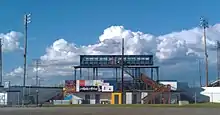
Fairbanks hosted the 2014 Arctic Winter Games from March 15–22, 2014.[49]
The Carlson Center is home to University of Alaska Fairbanks Nanooks men's ice hockey.
The Fairbanks Ice Dogs, a junior hockey team in the North American Hockey League, play at the Big Dipper Ice Arena. Prior to the formation of the Ice Dogs, the Fairbanks Gold Kings was formed as a league team by the Teamsters Local 959 in 1974. The team took on a life of its own beyond local league play, and played out of the Big Dipper for many years until moving to Colorado Springs, Colorado (becoming the Colorado Gold Kings) in 1998.
The Alaska Goldpanners and the Fairbanks AIA Fire are summer collegiate baseball teams, playing home games at Growden Memorial Park. The park is home to the annual Midnight Sun Game, an annual tradition since 1906, played without artificial lights starting after ten at night on the summer solstice.
The city was briefly represented in the Indoor Football League by the Fairbanks Grizzlies.
Also, Fairbanks is a hub for cross-country skiing in Alaska. It has hosted many different big ski events including the 2003 Junior Olympic Cross Country Ski Championship and the 2008 and 2009 U.S. Cross Country Distance Nationals[50] It also has an annual 50k race called the Sonot Kkaazoot and the Fairbanks Town Series races which consists of four different races and the Chest Medicine Distance Series races which consists of only 3 races.
Fairbanks is also home to the Yukon Quest, an international 1,000 mile sled dog race that is considered one of the toughest in the world. The race alternates its starting and finishing points each year between Fairbanks, Alaska and Whitehorse, Yukon.
Fairbanks is the starting and ending point for the Yukon 800 speedboat race, held annually in June.
Notable people
Fairbanks, Alaska was the birthplace of a significant number of musicians, artists, writers and personalities. They include Kelly Moneymaker, Kevin Johansen, Kevin Lenear of The Mighty Mighty Bosstones, Vivica Genaux, Lincoln Brewster, Rick Holmstrom, John Luther Adams, and Jon Button.
Susan Butcher, four time Iditarod winner, lived in Fairbanks.
James C. Hayes, mayor of Fairbanks (1992–2001), the first African-American mayor in the state of Alaska
Lance Mackey, four-time winner of the Yukon Quest and Iditarod sled dog races, lives in the Fairbanks area.
Fairbanks was also the starting place for Daryn Colledge, an offensive guard for the Arizona Cardinals. Colledge played for the Green Bay Packers and helped the team gain their victory in Super Bowl XLV.
Mike Dunlap, NBA and college basketball head coach, was born in Fairbanks. Ruthy Hebard, a first-round selection of the Chicago Sky in the 2020 WNBA draft, was raised from infancy in Fairbanks, attending West Valley High School.
Jessica Gavora is a conservative writer on culture and politics. She was the chief speechwriter for Attorney General John Ashcroft and a senior policy advisor at the Department of Justice.
The late John Drury Clark was born and raised in Fairbanks. He became a noted American rocket fuel developer, science fiction writer, and chemist.
Government and politics

The majority of Fairbanks is politically conservative, with three distinct geographical areas representing differing ideological views. The western part of the city, centered on the University of Alaska Fairbanks, is Democratic-leaning. The downtown area and the eastern parts near Fort Wainwright are Republican-leaning, and the North Pole area farther east is even more conservative. Thus, many residents have noted that a neighborhood's position on the map of Fairbanks (west to east) mirrors its political orientation (left to right).
Federal
The district centered on downtown Fairbanks typically votes for Republican candidates for president. The boundaries of the district have changed slightly in the elections listed here.
| Year | Democrat | Republican |
|---|---|---|
| 2020 | 47.2% | 47.7% |
| 2016 | 38.8% | 47.9% |
| 2012 | 42.2% | 52.8% |
| 2008 | 39.3% | 58.0% |
| 2004 | 35.2% | 61.5% |
State
At present, the Fairbanks area comprises two entire districts, and most of a third district, in the Alaska Senate. The state senators for the Fairbanks area are Democrat Scott Kawasaki and Republicans John Coghill Jr. and Click Bishop. The area comprises five entire districts, and a portion of one other district, in the Alaska House. Representatives for the Fairbanks area are Democrats Adam Wool and David Guttenberg, along with Republicans Bart LeBon, Steve Thompson, and Mike Prax, appointed to fill the seat after Tammie Wilson resigned in early 2020 (both Republicans). Dave Talerico, a Republican member of the House who lives in the Denali Borough community of Healy, represents Richardson Highway communities beyond the North Pole area but within the Fairbanks North Star Borough boundaries. The election of Nov. 2020 saw the retirement of Talerico and the defeat of Coghill for newcomers to the political system.
Downtown Fairbanks also voted for Democrat Mark Begich in his campaigns for U.S. Senate and governor, and for independent Bill Walker as governor in 2014.
Fairbanksans elected the first two Libertarian Party members to serve in a state legislature in the United States. Dick Randolph, who had previously served two terms in the Alaska House as a Republican, was first elected as a Libertarian in 1978 and re-elected in 1980. Ken Fanning was also elected to the House as a Libertarian in 1980. In the 1982 elections, Randolph ran unsuccessfully as the LP's nominee for Governor of Alaska, while Fanning lost re-election to the House to Democrat Niilo Koponen, following redistricting.
Fairbanks is a regional center for most departments of the State of Alaska, though the vast majority of state jobs are based in either Anchorage or Juneau.
Municipal
Fairbanks, unlike other larger cities in Alaska, still has separate borough and city governments. The City of Fairbanks was incorporated on November 10, 1903. The city council held a special meeting at the Carlson Center on November 10, 2003 for the express purpose of denoting the centennial of incorporation. The Fairbanks North Star Borough, created by the Alaska Legislature under the Mandatory Borough Act of 1963, was incorporated on January 1, 1964.
Police
The Fairbanks Police Department is the law enforcement agency responsible for the city. Since its establishment, 3 officers have died in the line of duty.[51]
Facilities and services
Utilities
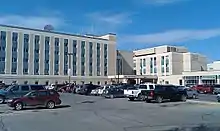
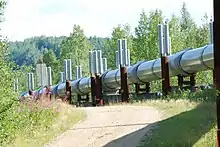
Electricity is provided by the Golden Valley Electric Association,[52] an electric cooperative formed in 1946 to serve areas that the City of Fairbanks' Municipal Utilities System (FMUS) didn't serve. In 1997, GVEA purchased the electric distribution system from FMUS. The downtown coal fired power plant was also purchased by Usibelli Coal Mine under the subsidiary Aurora Energy and contracts to provide power to GVEA. There are four steam turbines fueled by coal. Interior Alaska is not connected to the electrical grid of the contiguous United States and Canada, but a 138kv transmission line constructed in 1985 connects Fairbanks with electric companies serving the Southcentral Alaska area: Matanuska Electric Association, Chugach Electric Association and Homer Electric Association. Until 2019, GVEA held the world record for the largest rechargeable battery BESS,[53] which weighs approximately 1,300 tons. The battery was installed to help bridge the gaps that occur during power outages from the transmission line to Southcentral Alaska. The battery can provide 25 megawatts of electric for 15 minutes or provide power for 7 minutes to about 12,000 homes.[54]
The University of Alaska Fairbanks operates its own coal-fired generating station on campus, providing electricity and steam heat to university buildings.[55] As of 2019, a new fluidized bed 20 megawatt coal-fired power plant was completed, replacing the old dual boiler system [56]
Until 1996, telephone service was provided by the Fairbanks Municipal Utilities System (FMUS), owned by the City of Fairbanks. In that year, the voters in the City of Fairbanks authorized the sale of FMUS, which included telephone, electrical, and sewer and water. The telephone system was sold to PTI, a subsidiary of Pacific Power and Light, a subsidiary itself of PacifiCorp. However, PacifiCorp's purchase of The Energy Group, a diversified energy company with operations in the United Kingdom, Australia, and the U.S. with debt put pressure on PacifiCorp and they sold the telephone holdings to CenturyTel. [57] CenturyTel didn't hang onto it long, not being interested in the Alaska portfolio they had acquired from PacifiCorp. They sold the telephone utility to Alaska Communications, Inc., a private company, some of whom were Alaskans involved in the prior PTI company. Alaska Communications (ACS) had promised that Fairbanks was to be the corporate headquarters with a new building at the corner of Cushman St. and 1st Avenue. That changed as, in the process of acquiring the Fairbanks based telephone utility, the Anchorage Telephone Utility came up for sale, ACS purchased it and Anchorage became the headquarters for Alaska Communications Systems.[58]
General Communications Inc. (GCI has competed against ACS in Fairbanks since 1997 with installation of an earth station on the site of the former satellite monitoring system of the European Space Research Organization, now the European Space Agency.[59] GCI purchased ACS's mobile phone service from ACS in 2014, when ACS needed cash. [60] Other mobile providers are national companies AT&T Mobility and Verizon Wireless.[61]
A pair of fiber optic cables provide long-distance telephone and Internet service. One parallels the Parks Highway and connects Fairbanks to Anchorage, while the other parallels the Richardson Highway and connects Fairbanks to Valdez.[62] A third, spur fiber optic cable parallels the Trans-Alaska Pipeline and connects Fairbanks to Prudhoe Bay.[63] In 2020, Matanuska Telephone Association's subsidiary MTA Fiber Holdings has recently completed the AlCan One fiber installation from its prior connections from Wasilla to Fairbanks and North Pole, continuing down the Alaska Highway to the Canadian border where it connects with Canadian carriers. [64]
Broadband Internet access is provided by GCI, ACS, Ace Tekk and a handful of satellite Internet and wireless Internet services.[59][65]
Economy
Among the companies based in Fairbanks are Doyon, Limited.
Education
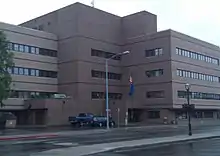
Fairbanks North Star Borough School District operates public schools serving the City of Fairbanks.
The Yukon–Koyukuk School District has its administrative headquarters in College CDP,[67] but its schools are in the Yukon-Koyukuk area, not Fairbanks.
Transportation

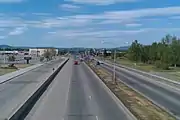

As the transportation hub for Interior Alaska, Fairbanks features extensive road, rail, and air connections to the rest of Alaska and Outside. At Fairbanks' founding, the only way to reach the new city was via steamboat on the Chena River.[68] In 1904, money intended to improve the Valdez-Eagle Trail was diverted to build a branch trail, giving Fairbanks its first overland connection to the outside world.[69] The resulting Richardson Highway was created in 1910 after Gen. Wilds P. Richardson upgraded it to a wagon road. In the 1920s, it was improved further and made navigable by automobiles, but it was not paved until 1957.[70]
Fairbanks' road connections were improved in 1927, when the 161-mile (259 km) Steese Highway connected the city to the Yukon River at the gold-mining community of Circle.[71] In 1942, the Alaska Highway connected the Richardson Highway to the Canadian road system, allowing road travel from the rest of the United States to Fairbanks, which is considered the unofficial end of the highway. Because of World War II, civilian traffic was not permitted on the highway until 1948.[72]
In the late 1960s and early 1970s, a series of roads were built to connect Fairbanks to the oil fields of Prudhoe Bay. The Elliott Highway was built in 1957 to connect Fairbanks to Livengood, southern terminus of the Dalton Highway,[73] which ends in Deadhorse on the North Slope.[74] West of the Dalton intersection, the Elliott Highway extends to Manley Hot Springs on the Tanana River.[73] To improve logistics in Fairbanks during construction of the Trans-Alaska Pipeline, the George Parks Highway was built between Fairbanks and Palmer in 1971.[75]
Until 1940, none of Fairbanks' surface streets were paved.[76] The outbreak of World War II interrupted plans to pave most of the city's roads, and a movement toward large-scale paving did not begin until 1953, when the city paved 30 blocks of streets.[77] During the late 1950s and the 1960s, the remainder of the city's streets were converted from gravel roads to asphalt surfaces.[78] Few have been repaved since that time; a 2008 survey of city streets indicated the average age of a street in Fairbanks was 31 years.[79]
Public transportation has been provided by the Metropolitan Area Commuter System, an agency of the borough government, since 1977. Bus service links much of the urban Fairbanks area, with most routes connecting at the downtown transit center. University Bus Lines, a private company, existed for several decades before MACS started. The company, which was owned first by Paul Greimann and later by Walt Conant, mainly linked downtown Fairbanks with the university campus and the military bases.
Air Transport
Fairbanks International Airport serves as a major hub for Alaska air travel. Several regional and charter airlines use or have used the location as their main base of operations due to its central location in the state. Commercial airlines also connect Fairbanks to the lower 48 and select international destinations. Fairbanks is the smallest city in the United States to be served by transatlantic flights, as Condor operates direct flight to Frankfurt in the summer tourist season.
Rail transport
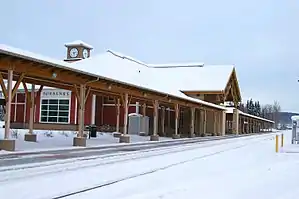

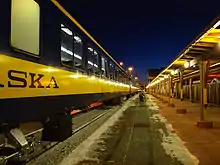
After large-scale gold mining began north of Fairbanks, miners wanted to build a railroad from the steamboat docks on the Chena River to the mine sites in the hills north of the city. The result was the Tanana Mines Railroad, which started operations in September 1905, using what had been the first steam locomotive in the Yukon Territory.[80] In 1907, the railroad was reorganized and named the Tanana Valley Railroad. The railroad continued expanding until 1910, when the first gold boom began to falter and the introduction of automobiles into Fairbanks took business away from the railroad.[80] Despite these problems, railroad backers envisioned a rail line extending from Fairbanks to Seward on the Gulf of Alaska, home to the Alaska Central Railway.[81]
In 1914, the US Congress appropriated $35 million for construction of the Alaska Railroad system, but work was delayed by the outbreak of World War I.[82] Three years later, the Alaska Railroad purchased the Tanana Valley Railroad, which had suffered from the wartime economic problems.[82] Rail workers built a line extending northwest from Fairbanks, then south to Nenana, where President Warren G. Harding hammered in the ceremonial final spike in 1923.[82] The rail yards of the Tanana Valley Railroad were converted for use by the Alaska Railroad, and Fairbanks became the northern end of the line and its second-largest depot.[82]
From 1923 to 2004, the Alaska Railroad's Fairbanks terminal was in downtown Fairbanks, just north of the Chena River. In May 2005, the Alaska Railroad opened a new terminal northwest of downtown, and that terminal is in operation today.[83] In summer, the railroad operates tourist trains to and from Fairbanks, and it operates occasional passenger trains throughout the year. The majority of its business through Fairbanks is freight.[84] The railroad is planning an expansion of the rail line from Fairbanks to connect the city via rail with Delta Junction, about 100 miles (160 km) southeast.[85]
Crime
Compared to communities of similar population, Fairbanks' crime rate (violent and property crimes combined) is higher than Alaska's average, which in turn is higher than the U.S. average.[86]
| Crime Types | U.S. | Alaska | Fairbanks |
|---|---|---|---|
| Violent Crime | 366 | 636 | 659 |
| Murder | 5 | 6 | 12 |
| Forcible Rape | 37 | 105 | 120 |
| Robbery | 102 | 85 | 160 |
| Aggravated Assault | 233 | 440 | 366 |
| Property Crime | 2,596 | 2,760 | 3,840 |
| Burglary | 543 | 428 | 477 |
| Larceny Theft | 1,837 | 2,096 | 2,984 |
| Motor Vehicle Theft | 216 | 236 | 379 |
Fairbanks similarly has a higher than average rate of rape and sexual assault, and in 2010 was ranked the third most dangerous U.S. city for women with 70 forcible rapes per 100,000 inhabitants.[88]
Attractions and points of interest
The city of Fairbanks and the greater Fairbanks area is home to a number of attractions and events, which draw visitors from outside of Alaska throughout the year. Summer tourist traffic primarily consists of cruise ship passengers who purchase package tours which include travel to Fairbanks. Many of these tourists spend one or more nights at a local hotel and visit one or more attractions. Tourism the rest of the year is mostly concentrated around the winter season, centered upon the northern lights, ice carving and winter sports. In addition, other events draw visitors from within Alaska, mostly from the community's trading area throughout Interior Alaska and the North Slope.
|
|
State Parks

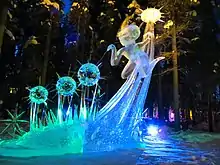
Alaska State Parks operates the Chena River State Recreation Site, a 29-acre (0.12 km2) park in the middle of Fairbanks with a campground, trails, and a boat launch. (There is a similarly named Chena River State Recreation Area, a much larger park, about 30 miles (48 km) outside Fairbanks)[89]
Sister cities
Fairbanks is twinned with:
Notes
- 1996 Alaska Municipal Officials Directory. Juneau: Alaska Municipal League/Alaska Department of Community and Regional Affairs. January 1996. p. 55.
- The boundaries for Alaska legislative districts were based upon 2010 Census data. The districts of Bishop and Wool contain a small portion of city limits which Fairbanks annexed after that census was completed, and which contains zero resident population.
- "2019 U.S. Gazetteer Files". United States Census Bureau. Retrieved June 30, 2020.
- "Population and Housing Unit Estimates". United States Census Bureau. May 24, 2020. Retrieved May 27, 2020.
- "Find a County". National Association of Counties. Archived from the original on May 31, 2011. Retrieved 2011-06-07.
- "Annual Estimates of the Resident Population for Incorporated Places in Alaska: April 1, 2010 to July 1, 2019". United States Census Bureau, Population Division. Retrieved May 26, 2020.
- "Alaska Population Estimates by Borough, Census Area, and Economic Region". Department of Labor and Workforce Development. Department of Labor and Workforce Development, State of Alaska. 2018. Retrieved April 2, 2019.
- Gibbon, Guy E. and Ames, Kenneth M. Archaeology of Prehistoric Native America: An Encyclopedia. Taylor & Francis, 1998. p. 116
- Gold Rush Town, p. 65
- U.S. Army. "Cultural resources at Fort Wainwright" Archived January 15, 2009, at the Wayback Machine,, www.usarak.army.mil. March 18, 2009. Accessed August 5, 2009.
- Aurora WebMasters. "History of Fairbanks". Fairbanks-alaska.com. Archived from the original on January 28, 2012. Retrieved January 29, 2012.
- "Gold Rush History". Explore Fairbanks. Fairbanks Convention and Visitors Bureau. Archived from the original on January 1, 2013. Retrieved January 28, 2013.
- "Vice Presidents of the United States: Charles W. Fairbanks" (PDF). Senate.gov. Archived from the original (PDF) on March 10, 2003. Retrieved October 24, 2012.
- Atwood, Evangeline; DeArmond, Robert N. (1977). Who's Who in Alaskan Politics. Portland: Binford & Mort for the Alaska Historical Commission. p. 84.
- Atwood and DeArmoun, Who's Who in Alaskan Politics, p. 4
- Like a Tree to the Soil: A History of Farming in Alaska's Tanana Valley, 1903 to 1940, by Josephine E. Papp and Josie A. Phillips
- "The Haines-Fairbanks Pipeline" (PDF). Arlis.org. April 2003. Retrieved November 19, 2015.
- Matheson, Janet; Haldeman, F. Bruce (1981). "Gilmore Trail". Historic Resources in the Fairbanks North Star Borough. Fairbanks: Fairbanks North Star Borough Planning Department. p. 19.
- "Fixing the Fatal Flaw of Fairbanks, Alaska Science Forum". Gi.alaska.edu. September 11, 2003. Archived from the original on June 15, 2010. Retrieved January 29, 2012.
- "Alaska Range Overlook Fairbanks, the Yukon, and the Interior Review". Fodor's Travel.
- U.S. Geological Survey. "Bulletin – United States Geological Survey, Issue 284", U.S. Geological Survey. 1906. P. 110.
- Geographic Names Information System. "Garden Island", U.S. Geological Survey. Accessed September 30, 2009.
- University of Melbourne. “World map of Köppen-Geiger climate classification” Archived March 25, 2009, at the Wayback Machine. climate.gi.alaska.edu. Accessed October 4, 2009.
- Staff Report. ‘Snow forecast for Fairbanks-area hills’ Archived September 25, 2009, at the Wayback Machine, Fairbanks Daily News-Miner. September 22, 2009. Accessed October 4, 2009.
- "Station Name: AK FAIRBANKS INTL AP". National Oceanic and Atmospheric Administration. Retrieved December 28, 2017.
- Rozell, Ned. ‘Albedo change about to alter Alaska’, Fairbanks Daily News-Miner. September 27, 2009. Accessed October 4, 2009.
- "NOWData - NOAA Online Weather Data". National Oceanic and Atmospheric Administration. Retrieved August 31, 2020.
- The Daily Beast. "America's 25 Coldest Cities". Accessed Feb 10 2015
- Mowry, Tim. "Record high temperature recorded in Fairbanks" Archived July 12, 2009, at the Wayback Machine, Fairbanks Daily News-Miner. July 8, 2009. Accessed October 7, 2009.
- Alaska Climate Research Center. “Fairbanks weather” Archived June 9, 2010, at the Wayback Machine, climate.gi.alaska.edu. Accessed October 7, 2009.
- Rozell, Ned. “Death of a Temperature Inversion”, Stories In The News. Ketchikan, Alaska. January 31, 2004. Accessed May 24, 2018.
- Fairbanks, Alaska is:. (November 13, 2012) but solar maximum elevation at the local noon is over 48 degrees at the disk center
- Greater Fairbanks Chamber of Commerce. “Climate” Archived June 3, 2009, at the Wayback Machine, fairbankschamber.org. Accessed October 7, 2009.
- Shulski, p. 154
- Mowry, Tim. ‘Chinook brings record temperatures to Interior Alaska’ Archived March 26, 2009, at the Wayback Machine, Fairbanks Daily News-Miner. January 16, 2009. Accessed October 7, 2009.
- Mowry, Tim. "Wildfires send worst air of the summer across Fairbanks" Archived August 1, 2009, at the Wayback Machine, Fairbanks Daily News-Miner. July 31, 2009. Accessed October 7, 2009.
- Staff Report. "Dense smoke cancels flights at Fairbanks airport" Archived August 8, 2009, at the Wayback Machine, Fairbanks Daily News-Miner. August 6, 2009. Accessed October 7, 2009.
- Cole, Dermot. "Dispelling some foggy notions about ice fog, inversions and Fairbanks weather", Fairbanks Daily News-Miner. January 4, 2009. Accessed October 7, 2009.
- Garrett, Jerry. "The cold show in Fairbanks, Alaska", The New York Times. March 2, 2007. Accessed October 7, 2009.
- "Temperature change in Alaska". climate.gi.alaska.edu. Alaska Climate Research Center. Retrieved September 24, 2019.
- Mean monthly maxima and minima (i.e. the highest and lowest temperature readings during an entire month or year) calculated based on data at said location from 1981 to 2010.
- Shulski, p. 155
- Alaska Climate Research Center. "Fairbanks International Airport, AK" Archived January 11, 2013, at the Wayback Machine, climate.gi.alaska.edu. Accessed October 4, 2009.
- "WMO Climate Normals for FAIRBANKS/INTL, AK 1961–1990". National Oceanic and Atmospheric Administration. Retrieved August 31, 2020.
- Cappelen, John; Jensen, Jens. "USA - Fairbanks, Alaska" (PDF). Climate Data for Selected Stations (1931-1960) (in Danish). Danish Meteorological Institute. p. 303. Archived from the original (PDF) on April 27, 2013. Retrieved March 14, 2016.
- "Census of Population and Housing". Census.gov. Retrieved June 4, 2015.
- "QuickFacts". Quickfacts.census.gov. May 13, 2006. Archived from the original on May 13, 2006. Retrieved August 23, 2018.
- "Fairbanks (city) QuickFacts from the US Census Bureau". Quickfacts.census.gov. Archived from the original on June 4, 2012. Retrieved November 19, 2015.
- "Welcome to the 2014 Arctic Winter Games - Fairbanks". Awg2014.org. Archived from the original on February 19, 2016. Retrieved November 19, 2015.
- "USA Distance Nationals – The usa distance nationals guru". Archived from the original on March 28, 2009.
- "Fairbanks Police Department, AK". The Officer Down Memorial Page (ODMP). Retrieved August 23, 2018.
- Golden Valley Electric Association website.
- Battery Energy Storage System
- Conway, Edmund (August 28, 2003). "World's biggest battery switched on in Alaska". The Daily Telegraph. London. Retrieved October 19, 2010.
- "UAF Facilities Services :: Division of Utilities". UNIVERSITY OF ALASKA FAIRBANKS. July 4, 2009. Archived from the original on July 4, 2009. Retrieved January 13, 2020.
- UAF completes new power plant.
- PacifiCorp HistoryFunding Universe. Acessed Dec. 20, 2020.
- Alaska Supreme Court. "Falke v. Fairbanks City Council", touchngo.com. June 12, 1998. Accessed August 1, 2009.
- GCI. "Company Overview" Archived May 5, 2010, at the Wayback Machine, GCI.com. Accessed September 30, 2009.
- Alaska Journal of Commerce Dec. 12, 2014, accessed Dec. 19, 2020
- "Coverage Viewer". AT&T. AT&T Wireless. Archived from the original on September 19, 2009. Retrieved September 30, 2009.
- Alaska Communications Systems. "Anchorage to Fairbanks Fiber" Archived September 12, 2009, at the Wayback Machine, acsalaska.com. Accessed September 30, 2009.
- GCI press release"GCI to acquire majority control of fiber optic system" Archived September 7, 2008, at the Wayback Machine, GCI.com. February 21, 2001. Accessed September 30, 2009.
- Alaska News Source May 26, 2020
- "ACS Personal Internet Service". acsalaska. Alaska Communications Systems. Archived from the original on September 28, 2009. Retrieved September 30, 2009.
- "Alaska Taxable 2008" (PDF). Commerce.state.ak.us. Archived from the original (PDF) on June 21, 2009. Retrieved October 24, 2012.
- Home page. Yukon–Koyukuk School District. Retrieved on June 16, 2016. "4762 Old Airport Way Fairbanks, AK 99709"
- Hendrick, pp. 14–15
- Hendrick, p. 21
- Alaska Department of Transportation and Public Facilities. "Richardson Highway north segment", dot.state.ak.us. Accessed October 7, 2009.
- The Milepost. "Steese Highway", Morris Magazine Network. Accessed October 7, 2009.
- The Milepost. "FAQ: Alaska Highway facts", The Internet Archive. September 29, 2007. Accessed October 7, 2009.
- The Milepost. "Elliott Highway", Morris Magazine Network. Accessed October 7, 2009.
- The Milepost. "Dalton Highway", Morris Magazine Network. Accessed October 7, 2009.
- The Milepost. "Parks Highway", Morris Magazine Network. Accessed October 7, 2009.
- Gold Rush Town, p. 114
- Gold Rush Town, p. 165
- Gold Rush Town, p. 178
- Eshleman, Christopher (October 2, 2009). "Fairbanks sales tax proposal differs from previous attempts". Fairbanks Daily News-Miner. Archived from the original on October 4, 2009. Retrieved October 7, 2009.
- "History of the Tanana Valley Railroad". Fairnet.org. May 15, 1907. Archived from the original on January 17, 2016. Retrieved November 19, 2015.
- Clifford, Howard. Rails North: The railroads of Alaska and the Yukon. Superior Publishing Co., 1981. P. 76.
- "The Alaska Railroad – History". Akrr.com. Archived from the original on January 5, 2007. Retrieved August 9, 2009.
- "Railroad facilities". akrr. The Alaska Railroad. Archived from the original on July 31, 2012. Retrieved October 7, 2009.
- "Report to the state of Alaska" (PDF). akrr. he Alaska Railroad. January 2009. Archived from the original (PDF) on July 7, 2011. Retrieved October 7, 2009.
- "Northern rail extension project". northernrailextension. The Alaska Railroad. Archived from the original on November 18, 2006. Retrieved October 7, 2009.
- "Fairbanks crime rates and statistics". neighborhoodscout. NeighborhoodScout. Retrieved November 19, 2015.
- Homefacts.com. "Crime Reports - Fairbanks, Fairbanks North Star Borough, AK". Homefacts.com. Retrieved August 10, 2016.
- "The Most Dangerous U.S. Cities For Women". Forbes.com. Retrieved November 19, 2015.
- "Chena River SRS". Dnr.state.ak.us. Retrieved August 23, 2018.
- "Data Visualizations – Asia – Sister Partnerships – Asia – Asia Matters for America". Data Visualizations – Asia – Sister Partnerships – Asia – Asia Matters for America.
- Associated, The (August 20, 2003). "Fairbanks mayor salvages sister-city relationship by agreeing to visit Italy | Juneau Empire – Alaska's Capital City Online Newspaper". juneauempire. Juneau Empire. Archived from the original on August 11, 2011. Retrieved January 29, 2012.
- "Governor Frank Murkowski – Alaska Trade and Development – 2005 Export Report". gov.state.ak. US State of Alaska. Archived from the original on February 5, 2012. Retrieved 2012-01-29.
- "Окружная администрация города Якутска". Yakutsk-city.ru (in Russian). Archived from the original on November 1, 2015. Retrieved November 19, 2015.
- "Fairbanks Yakutsk Sister Cities of the North". Fairbanks – Yakutsk, Sister Cities. 2012. Archived from the original on July 5, 2011. Retrieved December 17, 2012.
References
- Cole, Dermot. Fairbanks: A Gold Rush Town that Beat the Odds. Fairbanks. University of Alaska Press, 1999. ISBN 978-1-60223-030-9.
- Hedrick, Basil and Savage, Susan. Steamboats on the Chena. Fairbanks. Epicenter Press, 1988. ASIN B000OM7YIK.
- Shulski, Martha and Wendler, Gerd. The Climate of Alaska. University of Alaska Press, 2007. ISBN 978-1-60223-007-1.
Further reading
- Boswell, John. History of Alaskan Operations of United States Smelting, Refining, and Mining Company. Fairbanks. University of Alaska, Mineral Industries Research Laboratory, 1979.
- Cashen, William. Farthest North College President. Charles E. Bunnell and the Early History of the University of Alaska. Fairbanks. University of Alaska Press, 1972.
- Cloe, John and Monaghan, Michael. Top Cover for America. Missoula, Montana. Pictorial Histories Publishing Co., 1984.
- Cole, Terrence. The Cornerstone on College Hill: An Illustrated History of the University of Alaska Fairbanks. Fairbanks. University of Alaska Press, 1994.
- Cooley, Richard. Fairbanks, Alaska: A Survey of Progress. Juneau. Alaska Development Board, June 1954.
- Davis, Neil. The College Hill Chronicles: How the University of Alaska Came of Age. Fairbanks. University of Alaska Foundation, 1992.
- Dixon, Mim. What Happened to Fairbanks? The Effects of the Trans-Alaska Oil Pipeline on the Community of Fairbanks, Alaska. Boulder, Colorado. Westview Press, 1978.
- Kirchner, L. D. Flag Over the North, The Story of the Northern Commercial Company. Seattle. Superior Publishing Company, 1954.
- Kruse, John A. Fairbanks Community Survey. Fairbanks. Institute of Social and Economic Research, 1976.
- Movius, Phyllis. The Role of Women in the Founding and Development of Fairbanks, Alaska, 1903–1923. Fairbanks. University of Alaska Fairbanks, 1996.
- Naske, Claus, and Rowinski, L.J. Fairbanks: A Pictoral History. Virginia Beach, Virginia. The Donning Company, 1981.
- Patty, Ernest. North Country Challenge. New York. David McKay, 1949.
- Potter, Jean. Alaska Under Arms. New York. Macmillan, 1942.
- Potter, Jean. The Flying North. New York. Macmillan, 1947.
- Rickard, T.A. Through the Yukon and Alaska. San Francisco. Mining and Scientific Press, 1909.
- Robe, Cecil. The Penetration of an Alaskan Frontier, The Tanana Valley and Fairbanks. PhD dissertation, Yale University, 1943.
- Wickersham, James. Old Yukon. Washington, D.C. Washington Law Book Co., 1938.
- Wold, Jo Anne. This Old House. Anchorage. Alaska Northwest Publishing Co., 1976.
- Wold, Jo Anne. Fairbanks: The $200 Million Gold Rush Town. Fairbanks. Wold Press, 1971.
External links
- Official website of the City of Fairbanks
- Fairbanks Chamber of Commerce
- Fairbanks Convention and Visitors Bureau
- Fairbanks, Alaska at Curlie

